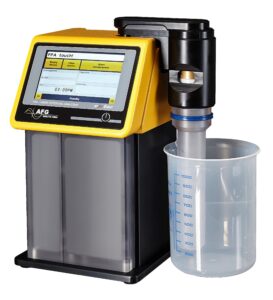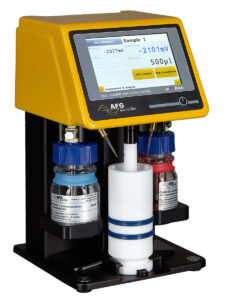As twins almost never alone, both together for an overall controlling and optimization of the wet end in the papermaking process: the CAS touch! Charge Analyzing System and the FPA touch! Fiber Potential Analyzer in one transportation case. Take them out, switch on and start measurements without assembling of any further parts.
 The papermaking is a complex and dynamic process that would end in a game of pure chance, if no controlling and optimization of this process is done to achieve the best quality of base paper or finished products. The first important section of the papermaking is the wet end. Monitoring the particle charge in the pulp suspension and the zeta potential of the fiber surface is the key for a successful and resource-efficient production process.
The papermaking is a complex and dynamic process that would end in a game of pure chance, if no controlling and optimization of this process is done to achieve the best quality of base paper or finished products. The first important section of the papermaking is the wet end. Monitoring the particle charge in the pulp suspension and the zeta potential of the fiber surface is the key for a successful and resource-efficient production process.
Besides fibers, fillers and fines, also trash particles can be found in the pulp suspension. The knowledge of the charge of chemicals, trash particles and fibers enables a correct and effective dosage of chemical additives. Usually, both, the fibers and trash particles in the pulp suspension are negative charged (anionic). Functional chemicals, which are used to affect the quality of the finished product, and process chemicals are mainly positively charged (cationic). After adding cationic chemicals to the suspension, the fibers shall attract them. But the cationic chemicals could also interact with the anionic trash particles and become ineffective, neutralize the trash particles and get lost via the white water. The product quality decreases, issues in the plants waste water treatment can occur and the costs increase.
The emtec CAS touch! Charge Analyzing System helps to determine the cationic demand in the filtrate (liquid parts) of suspension for a correct dosing of anionic trash catcher (ATC). This specific chemical has a high charge density and a high affinity to stick on anionic trash particles and therewith neutralizes them. Furthermore, the efficiency of the ATC can be checked by measuring the cationic demand again with the CAS touch! after adding. This strategy saves resources (and costs) and leads to an optimal process control.
Finally, the base paper or finished product should meet the required specifications to guarantee the optimal quality properties. Therefore, the negative charged fiber surface (anionic) should well interact with cationic (positive charged) functional chemicals like starch, wet/dry strength agent, optical brightener and so on. The main target of measurements with the emtec FPA touch!Fiber Potential Analyzer is to get information about the fiber surface charge for the determination of the optimal interaction between chemicals and fibers. Such a reaction is evoked mainly by the opposite charge of chemicals and fibers. A specific fiber surface charge or so-called Zeta Potential is required for the optimal adsorption of the necessary amount of chemicals. Any chemicals, which do not stick to the fibers, get lost with the white water.
For an optimal process control it is absolutely necessary to determine the complete charge environment in the wet end system. Otherwise, it is impossible to optimize the consumption of chemicals – desired properties of the finished product can, in the case of a non-optimal process control, only be guaranteed by overdosing.
For papermakers this issue is an old hat, but beside the used proven methods, both devices are state-of-the-art, have a touchscreen and offer new features for an effective, user-friendly and intuitive handling. Especially chemical suppliers appreciate their comfortable transport, because of their small size and light weight. This makes it possible to carry them together in one transportation case as well as in a carry-on-luggage as single devices.

